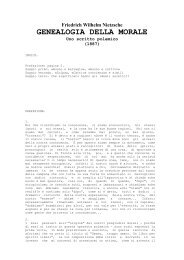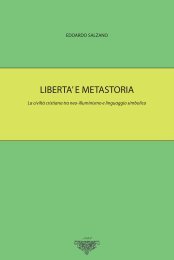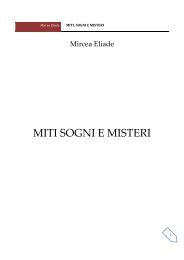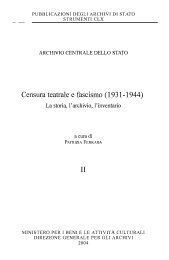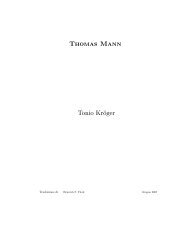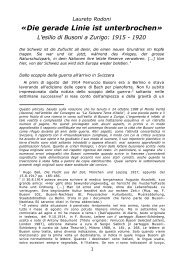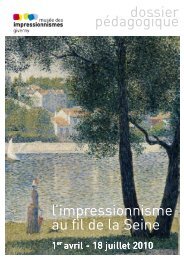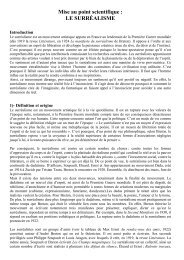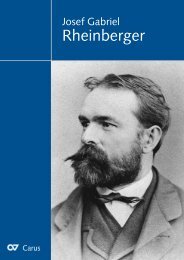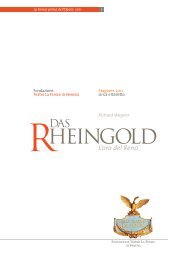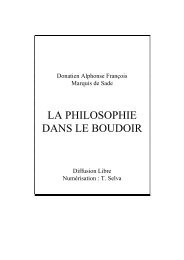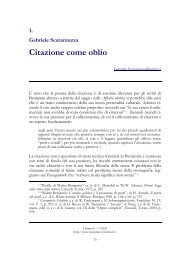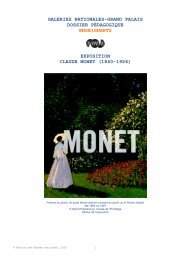Picasso - National Gallery of Art
Picasso - National Gallery of Art
Picasso - National Gallery of Art
Create successful ePaper yourself
Turn your PDF publications into a flip-book with our unique Google optimized e-Paper software.
<strong>Picasso</strong><br />
The Early Years<br />
1892–1906<br />
n ational gallery <strong>of</strong> art<br />
was h i n g to n<br />
March 30 –July 27, 1997<br />
Bell Atlantic is proud to sponsor<br />
this great exhibition
Pablo <strong>Picasso</strong>’s impact on the history <strong>of</strong><br />
m o d e rn art has been pr<strong>of</strong>ound. His early<br />
development was complex and innovative,<br />
constituting a subject <strong>of</strong> surprising<br />
depth. This exhibition is the first comp<br />
rehensive survey <strong>of</strong> <strong>Picasso</strong>’s art before<br />
cubism, from the academic and re a l i s t<br />
work <strong>of</strong> his youth to his emergence as a<br />
brilliant stylist in late 1906.<br />
Early Youth<br />
Pablo Ruiz <strong>Picasso</strong> was born on October 25, 1881,<br />
in the Spanish coastal town <strong>of</strong> Málaga, where his<br />
father, José Ruiz Blasco, was an art instructor at a<br />
provincial school. <strong>Picasso</strong> began to draw under his<br />
father’s tutelage and studied in various art schools<br />
between 1892 and 1897, including academies in<br />
Barcelona and Madrid. Working from live models as<br />
well as plaster casts <strong>of</strong> Greek and Roman sculpture<br />
(no. 2), the young artist displayed a precocious command<br />
<strong>of</strong> academic draftsmanship that would be evident<br />
throughout his career, later serving as the vehicle<br />
for some <strong>of</strong> his most original work.<br />
In addition to academic classicism, <strong>Picasso</strong>’s student<br />
work manifested a less idealized manner <strong>of</strong><br />
representation in genre subjects and portraiture. The<br />
artist executed many family portraits at this time<br />
and depictions <strong>of</strong> local figures such as an old sailor<br />
named Salmerón (no. 7), who was hired as a model<br />
by <strong>Picasso</strong>’s wealthy uncle in Málaga. In Madrid<br />
<strong>Picasso</strong>’s art was also shaped by visits to the Prado,<br />
no. 2. Study <strong>of</strong> a<br />
Torso,After a Plaster<br />
Cast, 1893/1894,<br />
Musée <strong>Picasso</strong>, Paris
no. 7. The Old Fisherman (Salmerón), 1895,<br />
Museu de Montserrat, Barcelona<br />
where he studied works by Spanish old masters<br />
Velázquez and Ribera as well as by El Greco (the<br />
latter’s stylized mannerisms would soon play an<br />
important role in <strong>Picasso</strong>’s work). During this period<br />
<strong>Picasso</strong> produced several large-scale pictures on<br />
religious and allegorical themes, which appeared in<br />
<strong>of</strong>ficial exhibitions. At the same time, he displayed<br />
an irreverent playfulness in works such as the Self-<br />
Portrait in a Wig (no. 12), in which the artist masquerades<br />
as an eighteenth-century Spanish noble.<br />
Modernism in Barcelona and Paris<br />
In Barcelona in 1899 <strong>Picasso</strong> rejected academic<br />
study and changed artistic direction by joining the<br />
circle <strong>of</strong> young avant-garde artists and writers who<br />
gathered at a local tavern, Els Quatre Gats. Known<br />
as modernistes or decadentes, this community<br />
assimilated contemporary international trends such<br />
as symbolism, which emphasized the evocation <strong>of</strong><br />
atmosphere and mood over literal description. In<br />
illustration, poster design, and other graphic arts,<br />
they turned to French art nouveau, which was distinguished<br />
by sinuous contour lines, simplified<br />
shapes, and artificial colors. Influences included<br />
Théophile Steinlen and Toulouse-Lautrec, whose<br />
impact can be seen in <strong>Picasso</strong>’s work. Adapting this<br />
style, the artist produced numerous portraits <strong>of</strong><br />
friends and acquaintances from Els Quatre Gats,<br />
among them Carles Casagemas and Jaime Sabartès<br />
(no. 29). <strong>Picasso</strong> included many <strong>of</strong> these in his first<br />
solo exhibition, which opened at the tavern in
no. 29. Sabartès<br />
Seated, 1900,<br />
Museu <strong>Picasso</strong>,<br />
Barcelona<br />
February 1900. In their art and writing young<br />
modernistes also devoted themselves to political<br />
anarchy and related social causes, including sympathy<br />
for the plight <strong>of</strong> the urban poor. Indeed, subjects<br />
from the streets <strong>of</strong> both Barcelona and Paris<br />
would soon occupy <strong>Picasso</strong>’s work.<br />
<strong>Picasso</strong> traveled to Paris several times beginning<br />
in 1900 before settling there permanently in 1904.<br />
Many aspiring avant-garde artists at the turn <strong>of</strong> the<br />
century moved to the French capital, where the<br />
work <strong>of</strong> post-impressionist painters Van Gogh,<br />
Cézanne, Seurat, Gauguin, and their disciples could<br />
be seen at the galleries and Salons. With vigorous<br />
comprehension, <strong>Picasso</strong> rapidly assimilated many <strong>of</strong><br />
these influences. Between 1900 and 1901 his work<br />
reflects a variety <strong>of</strong> new styles and techniques, such<br />
no. 40. Le Moulin de la Galette , 1900, Solomon R. Guggenheim<br />
Museum, New York, Thannhauser Collection, Gift Justin K.<br />
Thannhauser, 1978
no. 85. Crouching<br />
Woman, 1902,<br />
Collection <strong>Art</strong><br />
<strong>Gallery</strong> <strong>of</strong><br />
Ontario, Toronto,<br />
Anonymous Gift,<br />
1963<br />
as the introduction <strong>of</strong> bright, unmixed colors. Subjects<br />
included typical scenes <strong>of</strong> Parisian nightlife,<br />
such as his depiction <strong>of</strong> the dance hall Le Moulin<br />
de la Galette (no. 40), as well as portraits, such<br />
as the bold, posterlike image <strong>of</strong> Pere Mañach<br />
(no. 59), an art dealer who promoted <strong>Picasso</strong>’s<br />
work at the time.<br />
<strong>Picasso</strong>’s most important early exhibition took<br />
place in 1901 at the gallery <strong>of</strong> Ambroise Vollard<br />
(who represented the post-impressionists and<br />
younger members <strong>of</strong> the French avant-garde).<br />
Consisting largely <strong>of</strong> paintings and drawings in a<br />
variety <strong>of</strong> styles created during a brief period <strong>of</strong><br />
intense activity, the exhibition was a financial success<br />
for <strong>Picasso</strong> and brought him commissions for<br />
posters and magazine illustrations. It was reviewed<br />
by one critic, Félicien Fagus, as the debut <strong>of</strong> a “brilliant<br />
newcomer.” Fagus also wrote that “<strong>Picasso</strong>’s<br />
passionate surge forwards has not yet left him the<br />
leisure to forge a personal style.”<br />
The Blue Period<br />
In late 1901 <strong>Picasso</strong>’s work took a dramatic turn.<br />
Beginning with several paintings that commemorated<br />
the recent suicide <strong>of</strong> his friend Casagemas,<br />
the artist’s themes grew solemn and dark, and he<br />
adopted a palette devoted almost exclusively to<br />
shades <strong>of</strong> blue. The monochromatic use <strong>of</strong> blue was<br />
not uncommon in symbolist painting in Spain or<br />
France, where it was associated with representations<br />
<strong>of</strong> melancholy or despair. Such associations were<br />
well suited to <strong>Picasso</strong>’s subject matter, which<br />
focused on denizens <strong>of</strong> the underclass. Along with
the many indigents and misérables he portrayed in<br />
dark corners <strong>of</strong> unnamed streets and cafés (no. 85),<br />
<strong>Picasso</strong> depicted prostitutes and their children at the<br />
women’s prison <strong>of</strong> Saint-Lazare (no. 74) in Paris.<br />
Rather than show the specific circumstances <strong>of</strong><br />
their misfortune, however, he idealized his figures.<br />
Using elongated proportions derived from El Greco,<br />
<strong>Picasso</strong> metaphorically allows his subjects to escape<br />
their worldly fate and occupy a utopian state <strong>of</strong><br />
grace. Some are afflicted with blindness, a physical<br />
condition that symbolically suggests the presence <strong>of</strong><br />
spiritual inner vision.<br />
Throughout the Blue period <strong>Picasso</strong> also created<br />
intimate portraits <strong>of</strong> his bohemian comrades and<br />
acquaintances in Paris and Barcelona, who sought<br />
to identify themselves with society’s dispossessed.<br />
Their relative poverty lends Blue period subjects a<br />
certain self-pitying air. Indeed, in his masterpiece La<br />
Vie (no. 93) <strong>Picasso</strong> originally planned to depict<br />
himself as the protagonist, although he ultimately<br />
substituted a portrait <strong>of</strong> Casagemas. Historians<br />
interpret this somewhat mysterious work as an<br />
no. 93. La Vie, 1903, The Cleveland Museum <strong>of</strong> <strong>Art</strong>,<br />
Gift <strong>of</strong> the Hanna Fund
allegory <strong>of</strong> birth, death, and redemption. <strong>Picasso</strong>’s<br />
biographer John Richardson has further observed<br />
the appearance <strong>of</strong> gestures borrowed from Tarot<br />
cards and other arcane elements <strong>of</strong> mysticism. In<br />
this context the figures may refer to the theme <strong>of</strong><br />
sacred and pr<strong>of</strong>ane love, although precise meanings<br />
remain unclear.<br />
In the spring <strong>of</strong> 1904 <strong>Picasso</strong> finally settled in<br />
Paris, moving into a tumbledown residence in<br />
Montmartre known as the Bateau Lavoir, named for<br />
its resemblance to a laundry barge. The Parisian<br />
cabaret Le Lapin Agile replaced Els Quatre Gats as<br />
a gathering place for his circle <strong>of</strong> friends, sometimes<br />
called la bande à <strong>Picasso</strong> (“the <strong>Picasso</strong> gang”).<br />
Refining the exaggerated, now almost skeletal proportions<br />
<strong>of</strong> his figures, <strong>Picasso</strong> produced his most<br />
important early print, The Frugal Repast (no. 105),<br />
which depicts a destitute couple sharing a paltry<br />
meal <strong>of</strong> bread and wine. In addition to poverty and<br />
dolor, <strong>Picasso</strong>’s late Blue period work expresses a<br />
wider range <strong>of</strong> emotion. Intimacy, affection, and<br />
tender eroticism are seen in portraits <strong>of</strong> two mistresses,<br />
Fernande Olivier and a model now known<br />
only as Madeleine, the subject <strong>of</strong> Woman in a<br />
Chemise (cover image), one <strong>of</strong> the artist’s most delicate<br />
and sympathetic images. Perhaps unexpectedly,<br />
<strong>Picasso</strong> produced scurrilous caricatures and other<br />
satiric images at this time, indulging what became<br />
a lifelong taste for parody.<br />
The Saltimbanque<br />
In 1905 <strong>Picasso</strong> abandoned the palette and subject<br />
matter <strong>of</strong> the Blue period, turning to images <strong>of</strong> fairground<br />
and circus performers, whom he depicted in<br />
a range <strong>of</strong> chalky red hues. Accordingly, this phase<br />
<strong>of</strong> his work has come to be known as the Rose period.<br />
<strong>Picasso</strong> observed these figures firsthand at the<br />
Cirque Medrano, as well as in the streets and outskirts<br />
<strong>of</strong> the city, where a migrant community <strong>of</strong><br />
acrobats, musicians, and clowns— saltimbanques—<br />
entertained passing spectators. Such figures commonly<br />
occur in romantic and symbolist art and<br />
verse (from Daumier and Seurat to Baudelaire and<br />
Rimbaud), where the saltimbanque exists in a perpetual<br />
state <strong>of</strong> melancholy and social alienation. In<br />
the poems <strong>of</strong> Guillaume Apollinaire, one <strong>of</strong> several<br />
poets who were among the artist’s closest friends at<br />
this time, the acrobat acquires an air <strong>of</strong> mystery and<br />
enchantment that clearly corresponds to <strong>Picasso</strong>’s<br />
tone. Through paintings, watercolors, gouaches,<br />
drawings, and prints, <strong>Picasso</strong> tends to show his fairground<br />
performers at rest, <strong>of</strong>ten in domestic settings
no. 137. Family <strong>of</strong> Saltimbanques, 1905, <strong>National</strong> <strong>Gallery</strong> <strong>of</strong> <strong>Art</strong>,<br />
Washington, Chester Dale Collection<br />
that are genial and warm. Yet in keeping with their<br />
relatively impoverished circumstances and the<br />
saltimbanque’s traditional role as a symbol <strong>of</strong> the<br />
neglected artist, a pervasive ennui suffuses Rose<br />
period pictures.<br />
The paramount work in this series is the large<br />
Family <strong>of</strong> Saltimbanques (no. 137). Several preliminary<br />
studies for this composition exist, and x-radiography<br />
shows that <strong>Picasso</strong> attempted previous versions<br />
on the large canvas itself before arriving at the<br />
final image. Family <strong>of</strong> Saltimbanques is a summation<br />
<strong>of</strong> the fairground theme. Set within a desolate<br />
landscape, the vagabond troupe embodies a condition<br />
<strong>of</strong> collective alienation, as the figures gather yet<br />
fail to interact. The acrobat at the far left, bearing<br />
the artist’s features, is dressed as Harlequin, a wily<br />
character from eighteenth-century popular theater<br />
(commedia dell’arte) who would <strong>of</strong>ten serve as<br />
<strong>Picasso</strong>’s alter ego. An elegiac air also characterizes<br />
important paintings from this period that depart<br />
from the saltimbanque theme, such as Woman with<br />
a Fan and Boy with a Pipe (nos. 140, 138), which<br />
reveal a burgeoning classicism in his work.<br />
Gósol and After<br />
<strong>Picasso</strong> was now attracting the attention <strong>of</strong> new<br />
collectors and patrons, including the Americans<br />
Gertrude and Leo Stein, who were living in Paris
at the time. The first work by <strong>Picasso</strong> the Steins<br />
acquired was Harlequin’s Family with an Ape (no.<br />
122). It was at their apartment that the artist probably<br />
met Henri Matisse, whose work they had also<br />
begun to collect.<br />
In April 1906 <strong>Picasso</strong>’s fortunes greatly improved<br />
when Ambroise Vollard purchased most <strong>of</strong> his<br />
recent work. With finances secure, <strong>Picasso</strong> was able<br />
to travel, and in May he and Fernande left Paris for<br />
Spain, where they spent most <strong>of</strong> the summer in<br />
Gósol, a remote mountain village in the Pyrenees.<br />
In this rugged yet idyllic setting the artist returned<br />
to his Mediterranean roots, producing arcadian<br />
depictions <strong>of</strong> the male and female nude in addition<br />
to portraits and views <strong>of</strong> the sun-drenched hillside<br />
village (no. 148). For his portraits the artist used<br />
two somewhat divergent styles: an idealizing manner<br />
for weighty but refined images <strong>of</strong> Fernande; and<br />
a grittier, more realistic mode for depictions <strong>of</strong> Josep<br />
Fontdevila, an aging innkeeper with a criminal past<br />
who fascinated the artist.<br />
Following his return to the Bateau Lavoir,<br />
<strong>Picasso</strong> continued to explore the new direction his<br />
work had taken. In pictures such as Two Nudes (no.<br />
177) he showed female figures <strong>of</strong> monumental girth<br />
standing in abstract interior space. In addition to<br />
ancient Iberian sculpture and Spanish romanesque<br />
art, the bathers <strong>of</strong> Cézanne provided a prominent<br />
model for <strong>Picasso</strong>. The artist now relied on drawing<br />
to distill the formal and expressive properties <strong>of</strong> this<br />
new style. Experiments with bronze and ceramic<br />
sculpture also played a significant role. While<br />
<strong>Picasso</strong> largely avoided anecdote, his imagery loosely<br />
relates to the traditional theme <strong>of</strong> vanity; common<br />
subjects include a woman (usually Fernande)<br />
arranging her hair. About this time <strong>Picasso</strong> also created<br />
his most confident and imposing self-portrait to<br />
no. 148. Gósol Landscape, 1906, private collection
no. 177. Two<br />
Nudes, 1906,<br />
The Museum<br />
<strong>of</strong> Modern<br />
<strong>Art</strong>, New<br />
York, Gift <strong>of</strong><br />
G. David<br />
Thompson in<br />
honor <strong>of</strong><br />
Alfred H.<br />
Barr Jr.<br />
date (no. 182), portraying himself as something <strong>of</strong> a<br />
latter-day Cézanne.<br />
<strong>Picasso</strong>’s early career represents less a prologue<br />
to the later work than a restless and complex period<br />
<strong>of</strong> experimentation, struggle, and discovery. In this<br />
regard, the monumentality <strong>of</strong> the figures from late<br />
1906 brings the artist’s formative years to a conclusion.<br />
At the same time, the artist’s new treatment <strong>of</strong><br />
the figure and its ambiguous relationship to pictorial<br />
space heralded the emergence <strong>of</strong> cubism, a movement<br />
that would transform the history <strong>of</strong> twentiethcentury<br />
art.<br />
no. 182. Self-<br />
Portrait with<br />
Palette, 1906,<br />
Philadelphia<br />
Museum <strong>of</strong><br />
<strong>Art</strong>, A. E.<br />
Gallatin<br />
Collection
Special Programs<br />
S Y M P O S I U M<br />
Saturday, May 17, 10:15 a.m.-5:00 p.m.<br />
East Building Large Auditorium<br />
Scholars discuss <strong>Picasso</strong> and his socio-cultural milieu in<br />
Barcelona and Paris at the turn <strong>of</strong> the century: Michael<br />
FitzGerald, pr<strong>of</strong>essor <strong>of</strong> art history, Trinity College,<br />
Hartford; Temma Kaplan, pr<strong>of</strong>essor <strong>of</strong> history, State<br />
University <strong>of</strong> New York at Stony Brook; Marilyn McCully,<br />
art historian, London; Charles Rearick, pr<strong>of</strong>essor <strong>of</strong> history,<br />
University <strong>of</strong> Massachusetts at Amherst; John Richardson,<br />
<strong>Picasso</strong> biographer, New York; Debora Silverman, pr<strong>of</strong>essor<br />
<strong>of</strong> history, University <strong>of</strong> California at Los Angeles; Jeffrey<br />
Weiss, associate curator <strong>of</strong> twentieth-century art, NGA<br />
S U N DAY LECTURES<br />
4:00 p.m., East Building Large Auditorium<br />
March 30: Early <strong>Picasso</strong>, Jeffrey Weiss, associate curator <strong>of</strong><br />
twentieth-century art, NGA<br />
May 18: The Process <strong>of</strong> Painting: <strong>Picasso</strong>’s Hidden Pictures,<br />
Ann Hoenigswald, painting conservator, NGA<br />
I N T RO D U C TO RY TALKS<br />
Public tours and slide overviews given by staff lecturers.<br />
For dates and times consult the calendar <strong>of</strong> events at the<br />
<strong>Art</strong> Information Desks, or call (202) 842-6706. Tours by<br />
Special Appointment <strong>of</strong>fered weekdays: for adult groups <strong>of</strong><br />
twenty or more call (202) 842-6247; and for school groups<br />
call (202) 842-6249.<br />
F I L M S<br />
East Building Large Auditorium<br />
May 14 through 16 at 12:30; May 18 at 1:00<br />
Pablo <strong>Picasso</strong>: The Legacy <strong>of</strong> a Genius<br />
Directed by Michael Blackwood<br />
May 21 through 23 at 12:30; May 25 at 1:00<br />
<strong>Picasso</strong>: A Painter’s Diary<br />
Directed by Perry Miller Adato<br />
June 4 through 7 at 12:30<br />
The Unity <strong>of</strong> <strong>Picasso</strong>’s <strong>Art</strong>: A Lecture by Meyer Schapiro<br />
June 11 through 14 at 12:30; June 15 at 1:00<br />
The Mystery <strong>of</strong> <strong>Picasso</strong> (Le Mystère <strong>Picasso</strong>)<br />
Directed by Henri-Georges Clouzot<br />
May 28 through 31 at 12:30; June 1 at 1:00<br />
<strong>Picasso</strong>: The Saltimbanques<br />
FA M I LY PRO G R A M S<br />
Sundays from 1:00 to 3:00, children ages 10 through 14<br />
accompanied by an adult take a tour <strong>of</strong> the exhibition followed<br />
by an art activity. To register call (202) 789-3030.<br />
April 13 and 20: Creative Writing<br />
April 27 and May 11: Portraiture<br />
May 18 and June 1: Printmaking and Drawing<br />
EVENING WITH EDUCATORS<br />
Wednesday, April 9<br />
Evening program, held in conjunction with the Kennedy<br />
Center, includes a slide lecture and viewing <strong>of</strong> the exhibition.<br />
Open to all teachers K-12. Registration and a fee <strong>of</strong><br />
$20 required. For more information call (202) 842-6796.
EX TENSION PRO G R A M S<br />
<strong>Picasso</strong>: The Saltimbanques, a 16mm film or VHS videocassette<br />
(29 minutes) (#140) and viewers’ guide.<br />
<strong>Picasso</strong> and the Circus , a 16mm film or VHS videocassette<br />
(7 minutes) (#141) and activity guide.<br />
<strong>Picasso</strong>, a 16mm film (5 minutes)(#129).<br />
Extension programs available on a free-loan basis through<br />
the department <strong>of</strong> education resources, extension programs<br />
section, <strong>National</strong> <strong>Gallery</strong> <strong>of</strong> <strong>Art</strong>, Washington, DC 20565.<br />
C ATA L O G U E<br />
<strong>Picasso</strong>: The Early Years, 1892-1906, edited by Marilyn<br />
McCully, published by the <strong>National</strong> <strong>Gallery</strong> <strong>of</strong> <strong>Art</strong>, distributed<br />
by Yale University Press. Available from the <strong>Gallery</strong><br />
shops: $60.00 (hardcover); $32.00 (s<strong>of</strong>tcover). For information<br />
on ordering by mail call (301) 322-5900.<br />
Admission to the <strong>National</strong> <strong>Gallery</strong> <strong>of</strong> <strong>Art</strong> and to all <strong>of</strong> its<br />
programs is free except as noted.<br />
A DMISSION TO THE EXHIBITIO N<br />
Advance passes and same-day passes may be obtained free<br />
<strong>of</strong> charge in the East Building. Advance passes can be<br />
obtained also at all TicketMaster locations for a service<br />
charge <strong>of</strong> $2.00 per pass, and through TicketMaster<br />
PhoneCharge for a service fee <strong>of</strong> $2.75 per pass and a<br />
handling fee <strong>of</strong> $1.25 per order:<br />
Washington, DC<br />
Baltimore, MD<br />
Northern Virginia<br />
Nationwide toll-free<br />
(202) 432-s e at<br />
(410) 481-s e at<br />
(703) 573-s e at<br />
(800) 551-s e at<br />
For more information call (202) 842-6713<br />
GENERAL I NFOR MAT I O N<br />
For information about accessibility to galleries and public<br />
areas, assistive listening devices, sign language interpretation,<br />
and other services, please inquire at the <strong>Art</strong><br />
Information Desks, or call (202) 842-6690; TDD line<br />
(202) 842-6176 on weekdays only.<br />
A large-print version <strong>of</strong> this brochure is also available.<br />
The exhibition is organized by the <strong>National</strong> <strong>Gallery</strong> <strong>of</strong> <strong>Art</strong>,<br />
Washington, and the Museum <strong>of</strong> Fine <strong>Art</strong>s, Boston.<br />
The exhibition is supported by an indemnity from the<br />
Federal Council on the <strong>Art</strong>s and the Humanities. United<br />
Airlines is the <strong>of</strong>ficial carrier for this exhibition<br />
Brochure prepared by the department <strong>of</strong> twentieth-century<br />
art and produced by the department <strong>of</strong> exhibition programs<br />
and the editors <strong>of</strong>fice, <strong>National</strong> <strong>Gallery</strong> <strong>of</strong> <strong>Art</strong>.<br />
© 1997 Board <strong>of</strong> Trustees, <strong>National</strong> <strong>Gallery</strong> <strong>of</strong> <strong>Art</strong>,<br />
Washington. All works by Pablo <strong>Picasso</strong> © 1997 Estate <strong>of</strong><br />
Pablo <strong>Picasso</strong> / <strong>Art</strong>ists Rights Society (ARS), New York<br />
c ov e r : no. 112. Woman in a Chemise, 1904, Tate <strong>Gallery</strong>,<br />
London, Bequeathed by C. Frank Stoop, 1933



